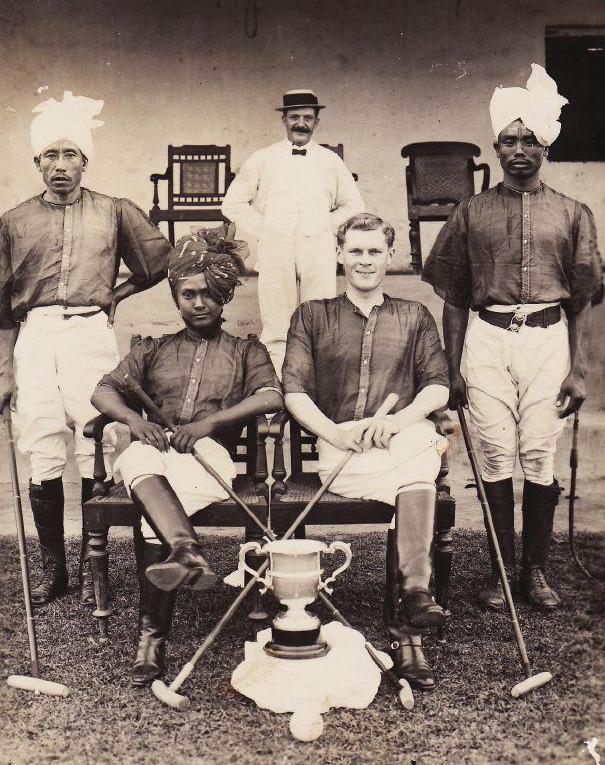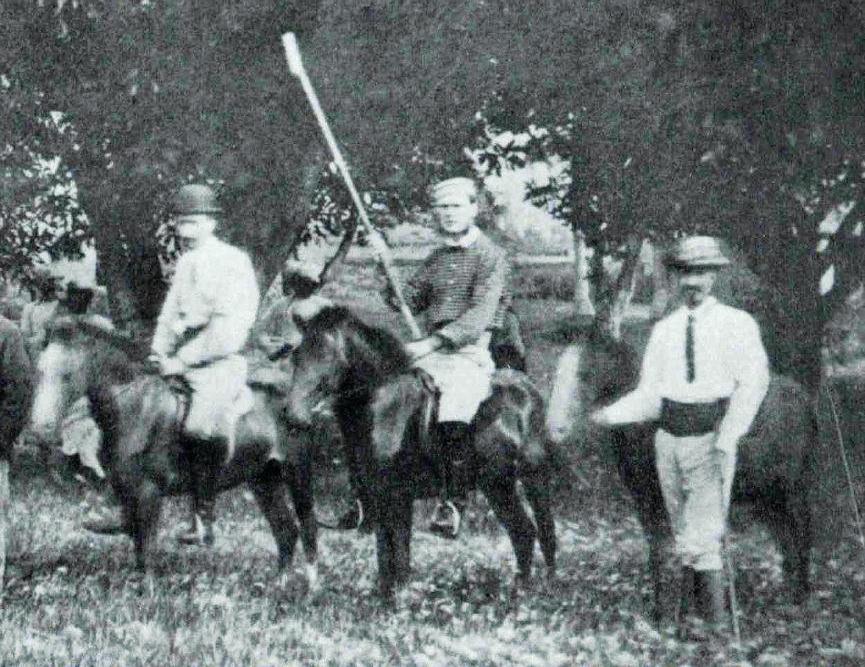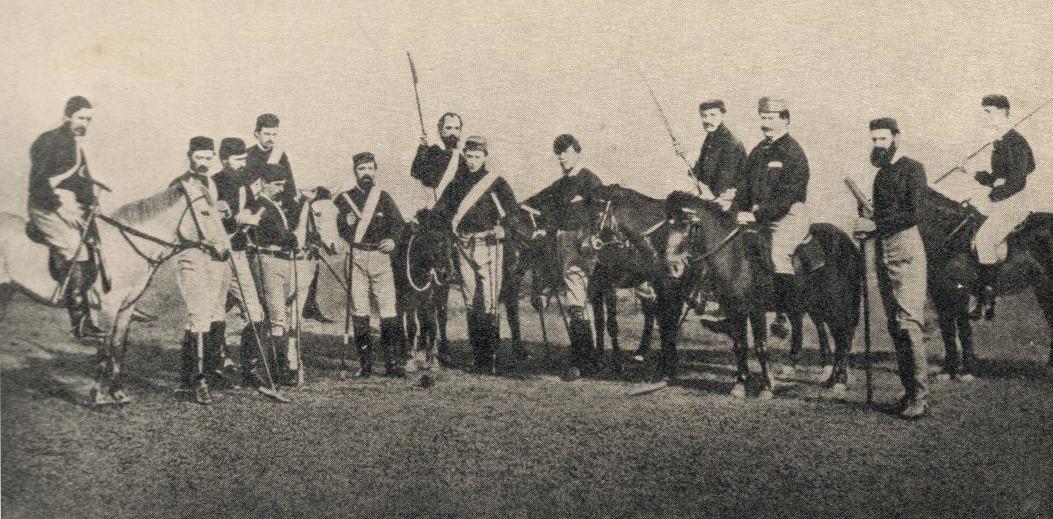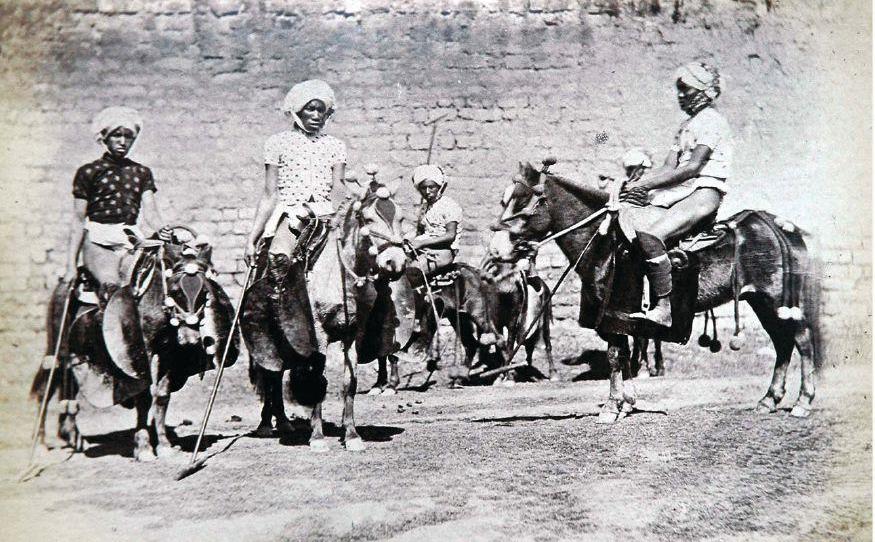
8 minute read
Yesteryears
Polo’s birthplace
Thoughts from Manipur as polo in England turns 150
By Rajkumar Nimai Singh, PhD
Maharaja Churachand Singh, seated left, with Chief Engineer Blackie, seated right, after playing at Kangla Fort, 1930. Polo is now 150 years old in England and is flourishing there and across the world. But as the year-long Polo150 events, organized by the UK Armed Forces Polo Association, closes at the 5th Manipur Statehood Day Women’s Polo Tournament, it is faltering. Attempts are being made to revitalize the modern game in Manipur, where it was once regarded as a game for both royalty and commoner alike. This will depend on the survival of the Manipuri pony, which is facing the threat of extinction due to the loss of grazing areas to development.
Polo has also seen a glorious but little-known chapter of the game in Manipur, the game’s
birthplace. This includes, remarkably, the first Manipur team to play internationally, in 1854; the first international game in Manipur, against the British, in 1855; and the first international tournament in Cachar in 1869.
According to Kangjeirol, a treatise of sagol kangjei (called hockey-on-horseback by Capt. Pemberton in 1835), King Kangba who ruled in Manipur in the pre-Christian era, introduced the game in a simple and crude style. It started in a festival known as Ukrong Hongba, during which Kangba showed his skill at dribbling a ball of bamboo root with his walking stick on the ground. He asked his people to play the game by sitting on horseback the next day. Accordingly, nobles and common people alike, after having lunch offered by the king, changed into new clothes and came to the venue of the festival with their ponies and started playing the game as innovated by the king. The game was witnessed by Queen Leima Tanu Sana who sat under a royal canopy amidst a huge crowd. Deriving from the name of the king, the game was known as sagol kangjei (sagol for horse or pony; and kangjei meaning Kangba’s stick).
There is also an account of a sagol kangjei match between the friends of Nongda Lairen Pakhangba, who ascended the throne of Manipur in 33 CE. On the occasion of introducing his queen, Laisana to the royal crowd, a game of sagol kangjei was played with seven players a side. The names of the players who played on that occasion were Marjing, Khamlangba, Irum Ningthou, Ikop Ningthou, Irong Ningthou, Nongshaba and Pureilomba on one side; and Thangjing, Khoriphaba, Wangbaren, Yangoi Ningthou, Mayokpa, Oknaren and Loyarakpa on the other. They are all ancestors who were later deified as gods. The seven players on each team were described as pan’ngakpa (goal keeper), pallak (stopper or half back), pan’ngakchang (half-back), langjei (center forward), pallak (attacking midfielder), panjenchang (goal striker assister) and panjenba (goal striker). Despite other sources claiming that the game was popular during the reign of King Kyamba (1467-1508), the first mention of the game in the court chronicle, called the Cheitharol Kumbaba, is during the reign of King Khagemba
(1597-1552) when it records a game of sagol kangjei played in 1606.
Due to the frequent invasions of Manipur by the Burmese during the late 18th and early 19th century, many Manipuris fled to neighboring Cachar and Sylhet to the west. As a pastime, they played the game of sagol kangjei very often. When Lt. Joseph Sherer was posted to the Sylhet Light Infantry in 1854, he saw the Manipuris playing the game in the open fields of Cachar. It struck him as a game that involved courage, skill, good horsemanship and presence of mind. He, along with Capt. Robert Steward, the assistant. deputy commissioner of Cachar, and the British tea planters at Cachar, started playing the game with the Manipuris there whenever they got the opportunity. These two officers are recorded as the first Englishmen to play the game of sagol kangjei.
In 1859, Steward succeeded his predecessor as deputy commissioner of Cachar. In the meantime, Sherer became the assistant. deputy commissioner. At their initiative, the Silchar Kangjei Club, the first polo club in the world was formed in 1859. The game then reached Calcutta, the capital of British India, where the Calcutta Polo Club was established in 1862. There were no written rules of the game, so the British framed written rules and got them approved in a meeting of the Silchar Kangjei Club held in1863. These rules were subsequently revised

in 1887 at Ambala. Polo teams from Manipur were sent to Calcutta and Delhi for exhibition matches in honor of visiting royal dignitaries during the British Raj. The game of sagol kangjei spread from Manipur to Cachar in Assam first, then to Calcutta in India, to England in 1869, and then to other countries.
Manipuris played under what is known as ‘leibak macha taba’ (or in a cultured manner) and anyone who failed to play in a refined manner was

The 1876 Manipuri team poses modestly before playing for the Prince of Wales and other dignitaries in Calcutta.
A stamp honors the Manipur polo players.
A player shows off the traditional garb and tack of Manipuri polo. Note the large leather flap hanging from the saddle.

ostracized. Such a person then could not even find a teammate, signaling the end of his polo-playing days. My grandmother Rajmata Shyamasakhi said the first rule of polo was made during the reign of my grandfather Maharaja Churachand (1891-1941) when ‘sagol tuppa’ was disallowed. A polo player had died when his pony was hit on its flank by another pony. As a consequence, riding a polo pony into the flank of another pony was disallowed.
In sagol kangjei, there are no goal posts and a goal is scored if the ball simply crosses the goal line. The ball can also be held by the hand but once in hand, players of the opposing team may hit that player with their mallets. Once he lets go of the ball, he may not be touched with a mallet. There was no time limit in a game of sagol kangjei. A match is decided in advance by the number of goals to be played. If a 15- goal game is agreed upon, the game will end when a combined 15 goals have been scored, like at 15-0, or 14-1, or 13-2, and so on.
The Manipuri’s love for his pony is best
exemplified by an instance recorded in Principal Heads of the History and Statistics of the Dacca Division, Calcutta, 1868, where it reads that when Prince Marjit was defeated by his brother Chourjit, he fled to Cachar, bringing with him his chestnut polo pony. The brother of the Cachar’s King Govind Chunder took a liking to the pony. He offered Marjit any price he desired but was turned down. Govind Chunder then seized the pony by force. Marjit joined forces with his younger brother Prince Gambhir Singh, together defeated Chourjit, and demanded the return of his pony from Govind Chunder. Upon being refused, Marjit and his Burmese allies attacked Cachar, and burned down Govind Chunder’s palace. All this because of a polo pony.
The Cheitharol Kumbaba is silent about sagol kangjei from 1819 until 1826. This was the period when Manipur was under Burmese occupation. On April 10, 1827, during Maharaja Gambhir Singh’s reign, the chronicle records a match between the royal family and the Angom clan, which was won by the royal family. Another entry is found during the regency of Nara Singh, that on May 24, 1838, a senior citizens’ polo match took place. There are a number of entries during the reign of Maharaja Nara Singh (1844-1850). They included a game among the princes, dark and light teams, on Feb. 28, 1847; a game on March 3, 1847, when the people defeated the princes; and on Sept. 28, 1847 between the king’s sons and his sons-in-law. In other words, after regaining Manipur from the Burmese, the game of sagol kangjei flourished once again in Manipur.
The chronicle also meticulously records that British officers in Manipur left for Cachar to play polo on Sunday, Oct. 29, 1854 and returned on Tuesday, Nov. 3, 1854. There is also a chronicle entry that on Monday, Jan. 29, 1855, there was a polo match in Imphal between Empress Victoria’s Army and the 3rd Bn. Manipur Levy, during which Jamadar Nepram of the latter suffered a head injury. This is arguably the first international polo game in Manipur.
There is also a rather humorous entry in the court chronicle. On Dec. 9, 1869, an 11-member team of Manipuri polo players comprised of Langmaithem Chandrakanti, Aheibam Madhu Singh, Konkham Kesho, Thokchom Nawang, Phurailatpam ‘the Brahmin’ Manik, Yengkhom Chaoba, Hijam Angangmacha, Shoraosam Tonkraba, the Machahal

The 1876 Calcutta Polo Club team that faced off against the Manipuri team in an exhibition in honor of the Prince of Wales’ visit.
Lt. Sherer, far right, founder of the Calcutta Polo Club, was instrumental in popularizing Manipuri polo among English colonials in India.


Charter members of the Calcutta Polo Club. The club is the oldest club still in existence.
During the late 18th and early 19th century, Manipuris fled to Cachar and Sylhet, where they played sagol kangjei.

(a havildar of the Voluntary Corps), Yellangbam Cheiteinya, the Hajaree (Captain of the Voluntary Corps) Yambem Pedam Singh and Shamurailatpam Kama left for Tuwa Tuli with 33 polo ponies to play against the British tea planters.
In the first match of 13 goals, the British could not score even once. So, it was replayed with the addition of three more players on the British side but they could score only two goals. The match was again
replayed with yet another two additional players on the British side—that is seven players versus 12—but the British could score only one goal. On the next day, a match was played for 17 goals. The British side of nine players scored only two goals. Thus the Manipuri team won both the matches. These matches in 1869 may be called the first international matches pre-dating the first international polo cup between England and USA in 1876. •












